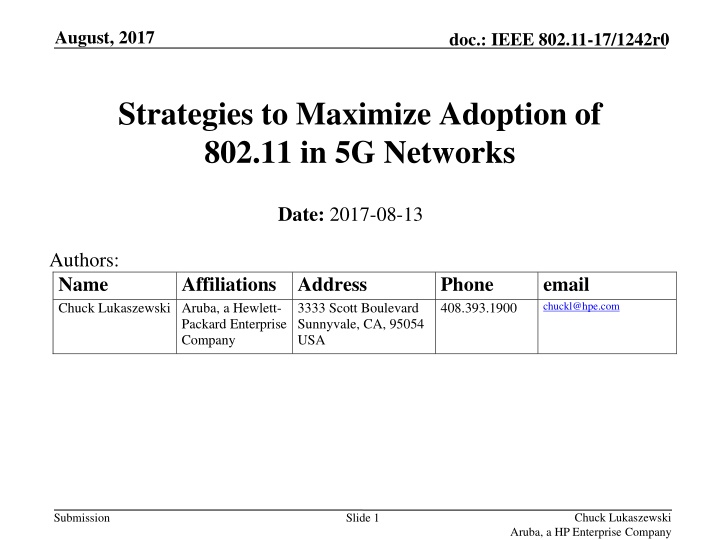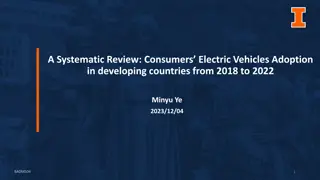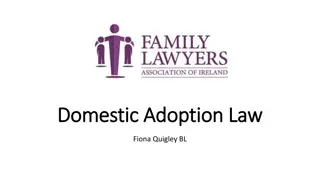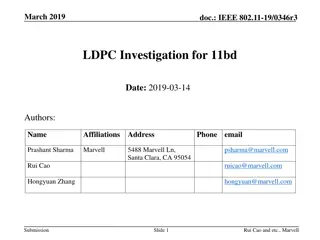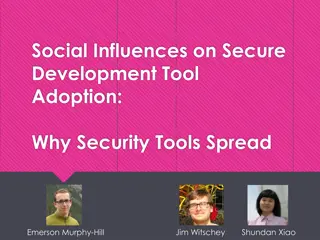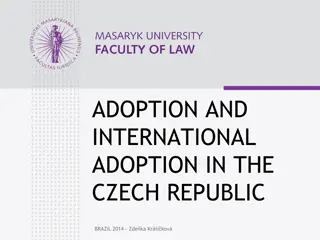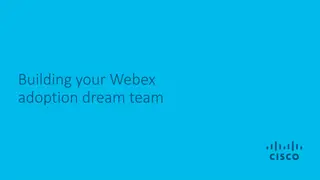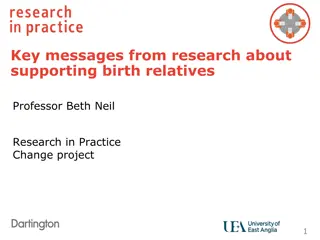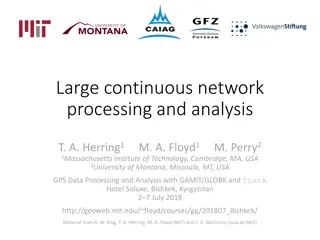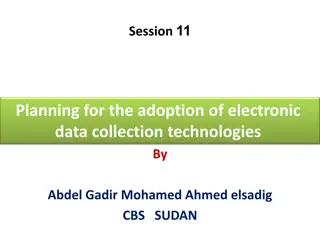Strategies to Maximize Adoption of 802.11 in 5G Networks
Reframe the LTE vs. Wi-Fi debate in the context of 5G at a system and business model level. Explore the emergence of unlicensed LTE and the better together opportunities with Wi-Fi. Address technical, organizational, and procedural challenges for community action. Highlight the significance of Wi-Fi integration for the success of 5G networks.
Download Presentation

Please find below an Image/Link to download the presentation.
The content on the website is provided AS IS for your information and personal use only. It may not be sold, licensed, or shared on other websites without obtaining consent from the author.If you encounter any issues during the download, it is possible that the publisher has removed the file from their server.
You are allowed to download the files provided on this website for personal or commercial use, subject to the condition that they are used lawfully. All files are the property of their respective owners.
The content on the website is provided AS IS for your information and personal use only. It may not be sold, licensed, or shared on other websites without obtaining consent from the author.
E N D
Presentation Transcript
August, 2017 doc.: IEEE 802.11-17/1242r0 Strategies to Maximize Adoption of 802.11 in 5G Networks Date: 2017-08-13 Authors: Name Chuck Lukaszewski Aruba, a Hewlett- Affiliations Address Phone 408.393.1900 email chuckl@hpe.com 3333 Scott Boulevard Sunnyvale, CA, 95054 USA Packard Enterprise Company Chuck Lukaszewski Submission Slide 1 Aruba, a HP Enterprise Company
August, 2017 doc.: IEEE 802.11-17/1242r0 Abstract Reframe the LTE vs. Wi-Fi debate Consider 5G at a system & business model level Put 5G RATs including Wi-Fi into a broader context Explain the emergence of unlicensed LTE in evolutionary terms Explain the huge better together opportunity Offer a viewpoint on technical, organizational & procedural challenges Propose specific actions to take as a community Chuck Lukaszewski Submission Slide 2 Aruba, a HP Enterprise Company
August, 2017 doc.: IEEE 802.11-17/1242r0 Presenter s Note This presentation represents a personal viewpoint regarding systemic issues faced across the Wi-Fi ecosystem to hold and grow market share in operator networks. Its scope intentionally goes beyond IEEE 802, and certain IEEE presentation conventions are not followed. The terms 802.11 and Wi-Fi are intentionally used interchangeably to draw a wider point. A variety of WFA programs are deliberately mentioned by name. A form of this presentation was delivered as a keynote address to the Wi-Fi Alliance in June, 2017. It is being delivered to AANI SC at the request of the Chair. Chuck Lukaszewski Submission Slide 3 Aruba, a HP Enterprise Company
August, 2017 doc.: IEEE 802.11-17/1242r0 5G cannot succeed without Wi-Fi We need to look past LAA / LTE-U Operators ultimately don t care what RAT wins just cost and efficacy In 4G, a key driver of unlicensed LTE development is failure of Wi-Fi to address charging/PCRF, discovery & mobility requirements in a manner acceptable to operators 5G radio aggregation techniques natively incorporate 802.11 as a peer 5G RAT Family (5GRF) member, and effectively render Hotspot 2.0 unnecessary for SIM-based devices This unlocks cooperative win/win outcomes that were not feasible in 4G Chuck Lukaszewski Submission Slide 4 Aruba, a HP Enterprise Company
August, 2017 doc.: IEEE 802.11-17/1242r0 Wi-Fi Does Not Compete Directly With 5G The parent SDOs have radically different scopes & approaches 802.11 & WFA thinking is atomic - it starts at the AP/STA and stops at BSS By contrast, 3GPP starts from the subscription, works backwards to a system, and finally on to all of the constituent elements. Even WFA certifications like HotSpot 2.0 are not operator-ready ; hence need for Wireless Broadband Alliance At the end of the day, 802.11 is simply a layer-2 bridging technology In most deployments, 802.11 radios are small parts of a larger system Wi-Fi is a component; 5G is a system of vastly higher complexity If 802.11 is a type of engine, 5G would be the cars plus the road network. At most we can say that Wi-Fi competes with specific 3GPP RATs in specific frequency bands Chuck Lukaszewski Submission Slide 5 Aruba, a HP Enterprise Company
August, 2017 doc.: IEEE 802.11-17/1242r0 What Is 5G ? 4G Evolved Packet System (EPS) 5G is a strategy 5G is an eight layer architecture It is a massive shift in how mobile operators provision services, forward traffic, manage competition, reduce costs and monetize subscribers Main focus is on composability, modularity, service agility, virtualization, and datapath flexibility 5G is RAT agnostic and is building around Wi-Fi 5G is decentralized 5G Next Generation Mobile Network Chuck Lukaszewski Submission Slide 6 Source: 5G White Paper , Next Generation Mobile Networks Alliance, V1.0, 2015-02 Aruba, a HP Enterprise Company
August, 2017 doc.: IEEE 802.11-17/1242r0 5G Strategy Example Network Slicing 5G network slicing enables subscriber-specific custom virtualized datapaths to be dynamically provisioned, even spanning multiple physical network owners Slide 7 Chuck Lukaszewski Submission Source: 5G White Paper , Next Generation Mobile Networks Alliance, V1.0, 2015-02 Aruba, a HP Enterprise Company
August, 2017 doc.: IEEE 802.11-17/1242r0 Decoupling the RAN with Multi-Connectivity TR 23.799 introduces a network convergence sublayer (NCS) to explicitly enable independent evolution of RAN and core Explicit mechanisms for managing Wi-Fi STA attach and mobility (including EAP-AKA key material exchange based on LWA) are being designed UEs may have multiple, active RATs with varying capabilities anchored on different eNB / gNB / Wi-Fi / mmW or other serving radios Chuck Lukaszewski Submission Source: 3GPP TR 23.799, Study on Architecture for Next Generation System, V14.0.0, 2016-12 Slide 8 Aruba, a HP Enterprise Company
August, 2017 doc.: IEEE 802.11-17/1242r0 5G Enables Radically New Operator Landscape Next-Gen Neutral Host Next-Gen Virtual NO Wholesale NO Legacy MSO Legacy MNO 5G-NGC 5G-NGC 5G-NGC 5G-NGC 5G-MRA 5G-MRA 5G-MRA 5G-MRA Wi-Fi CBRS CBRS Macro SCell Wi-Fi Wi-Fi SCell SCell DAS CPE CPE CPE CPE CPE CPE CPE CPE Own UEs Roaming UEs Own UEs Roaming UEs Roaming UEs Own UEs Roaming UEs Chuck Lukaszewski Submission Slide 9 Aruba, a HP Enterprise Company
August, 2017 doc.: IEEE 802.11-17/1242r0 5G Combines Best of LWA & LWIP Similar to R13/14 LWA, the 5G control plane allows programming UE with WLAN profiles, attachment policies, and keying material. Hotspot 2.0 is no longer necessary. PCRF accounting is fully integrated. Both trusted & untrusted modes are supported, effectively merging LWA & LWIP Allows Wi-Fi to compete on equal footing with 3GPP RATs Chuck Lukaszewski Submission Source: 3GPP TR 23.799, Study on Architecture for Next Generation System, V14.0.0, 2016-12 Slide 10 Aruba, a HP Enterprise Company
August, 2017 doc.: IEEE 802.11-17/1242r0 There s Just One Small (Cell) Problem Gigabit LTE requires pervasive indoor small cells in places people work, shop, travel and relax. This problem is also RAT agnostic: L/S bands: 4SS MIMO + 3 Carrier Agg + HO modulations C band: Bonding (unlicensed or LSA) Ka/V bands: Bonding (licensed or unlicensed) Only 1.5 million indoor enterprise small cells were installed by YE16 Small Cell Forum forecasts show Wi-Fi lead growing from 14M in 2016 to 20+M in 2020. Annual Shipments of Indoor Non-Residential Wi-Fi APs vs. Licensed Small Cells 30M 25M 20M 15M 10M 5M 0M 2013 2014 2015 2016 2017 2018 2019 2020 2021 Wi-Fi Small Cell Chuck Lukaszewski Submission Slide 11 Aruba, a HP Enterprise Company Sources: Dell Oro Group, Small Cell Forum Market Status Reports
August, 2017 doc.: IEEE 802.11-17/1242r0 Current Small Cell Models Are Flawed Small cells have failed due to a structural funding model problem Enterprises are almost completely resistant to purchasing small cells for coverage Operators could easily fund a global indoor small cell buildout for < $60B But such an investment produces no incremental revenue! Multiple, separate physical small cell layers are required to aggregate 5 GHz S-Cells must be deployed 2-4X more densely than <2 GHz P-Cell mmW S-Cells must be deployed 8-20X more densely than <2 GHz P-Cell Indoor non-residential small cells are failing at licensed wavelengths Wi-Fi is inherently neutral host, and cost per bit easily beats LTE Like any for-profit business, operators must carry bulk of their cost by cheapest means Chuck Lukaszewski Submission Slide 12 Aruba, a HP Enterprise Company
August, 2017 doc.: IEEE 802.11-17/1242r0 Understanding the Better Together Opportunity In 2021 Wi-Fi will be the dominant indoor aggregation technology Universal connectivity layer for both SIM and non-SIM based devices Capex & opex are already baked into end-user IT budgets Wi-Fi will keep lowest cost/bit (barring radical operator/silicon business model change) 11ax and 5G are naturally complementary. 3GPP is designing user & control plane for Wi-Fi from ground up on both ends of link 11ax is capable of being an operator grade air interface Chuck Lukaszewski Submission Slide 13 Aruba, a HP Enterprise Company Source: Cisco VNI Global Mobile Data Traffic Forecast Update, 2016-2021, February, 2017
August, 2017 doc.: IEEE 802.11-17/1242r0 What Does Success Look Like? 802.11 is the predominant indoor mid-band RAT, carrying vast majority of operator bulk traffic (regardless of spectrum holdings) Unlicensed LTE / NR is deployed selectively by MNO/MSO to address specific scenarios Managed Wi-Fi systems are transparently integrated as trusted WTs in 5G networks, including network discovery, key exchange, and mobility Including MSO-managed residential & SMB systems with Wi-Fi CPE Only standalone home wireless routers/clusters would operate untrusted Requires significant Wi-Fi engagement with 3GPP SA to help define interfaces Wi-Fi continues to be prominently visible user choice on SIM-based UEs We still need to improve HS2.0 for non-SIM devices and enterprise use cases Chuck Lukaszewski Submission Slide 14 Aruba, a HP Enterprise Company
August, 2017 doc.: IEEE 802.11-17/1242r0 What Must We Do to Achieve This Vision? Meet or Exceed 3GPP RAT Minimums Close Operator Technology Gaps Improve Our Processes 100% bearer encryption with pairwise keys Radically accelerate 802.11 innovation Complete MBO, OCE expeditiously Native support for 5G signaling (next- gen Xw and N3IWF) in Wi-Fi ESS/BSS Improve member participation on critical programs Ultra-high QoS/GBR Deterministic mobility Engage at 3GPP Tell our story better, especially mission criticality of Wi-Fi to global economy Ensure wide & timely deployment Chuck Lukaszewski Submission Slide 15 Aruba, a HP Enterprise Company
August, 2017 doc.: IEEE 802.11-17/1242r0 We Have to Modernize Security Unencrypted radio bearers have been gone from 3GPP since 2008 LTE has never used shared keying material. Too complex to configure, leading to bad behavior. Open PSK 802.1X Chuck Lukaszewski Submission Slide 16 iPass 2017 Mobile Security Report (Survey of 500+ CIOs), May, 2017 Aruba, a HP Enterprise Company
doc.: IEEE 802.11-17/1242r0 We Have Solutions It s Time to Admit Problem Open Preshared Key Enterprise 802.1X Opportunistic Wireless Encryption (OWE) RFC 8110 Provides encryption of the wireless medium but no authentication Based on ephemeral pairwise keys negotiated via Diffie- Hellman exchange on association Simultaneous Authentication of Equals (SAE) Defined in 802.11s RFC 6617 (IKEv2) Password authenticated key exchange with commit / confirm methodology Resistant to dictionary attack EAP-PWD RFC 8146 & 5931 Simple EAP exchange with full mutual authentication using shared secret, and no certificate Existing support in Android, Windows 802.11ai FILS provides public key authentication without certificates Allows fully encrypted Open mode with no user workflow change! Pairwise encryption, mutual auth & forward secrecy! Solves numerous well known 802.1X usability problems Chuck Lukaszewski Submission Aruba, a HP Enterprise Company
August, 2017 doc.: IEEE 802.11-17/1242r0 3GPP Feature Velocity Is Accelerating 3GPP RELEASE DURATIONS Months Between Releases Months to Complete UMTS Release 1999 Release 4 Release 5 IMS, HSDPA Release 6 WLAN, HSUPA Release 7 LTE, OFDMA, 3G SC, UL-MU-MIMO Release 8 Release 9 3G 2C Agg, 4G SC Release 10 LTE-A, 3G 4CA, DL-MU-MIMO Release 11 CoMP, SaMOG Release 12 Dual Connectivity, SIPTO, HSPA+ Release 13 LAA, LWA, LWIP, NB-IOT, LTEm Release 14 eLAA, eLWA 60GHz , eLWIP Release 15 5G 0 10 20 30 40 50 60 70 80 Chuck Lukaszewski Submission Slide 18 Aruba, a HP Enterprise Company Source: http://www.3gpp.org/specifications/67-releases
August, 2017 doc.: IEEE 802.11-17/1242r0 While 802.11 is Decelerating IEEE PAR to Draft 2.0 TGg TGn TGac IEEE PAR to RevCom TGax TGad TGa 0 10 20 30 40 50 60 70 80 TGb TGg TGn TGac TGax IEEE Draft 2.0 to Previous D2.0 TGad 0 10 20 30 40 50 60 70 80 TGg TGn 3GPP Median TGac TGax 0 10 20 30 40 50 60 70 80 3GPP Median Chuck Lukaszewski Submission Slide 19 Aruba, a HP Enterprise Company Sources: http://www.ieee802.org/11/Reports/802.11_Timelines.htm
August, 2017 doc.: IEEE 802.11-17/1242r0 Summary Good News Wi-Fi and 5G do not compete directly. Spectrum is more important to 3GPP than any specific RAT Wi-Fi is a small component in a vastly larger end-to-end system The pressures driving 3GPP to unlicensed have nothing to do with Wi-Fi PHY/MAC competition in 5 GHz is a byproduct of an inevitable 3GPP trajectory Dual connectivity, carrier agg, convergence layers are long term secular trends 5G is ironically solving many of the longstanding Wi-Fi integration problems and removing incentive to use LAA Bad News Unlicensed LTE is above all the 3GPP verdict on Wi-Fi community s failed attempts to integrate with cellular networks Arguably, success of S2b and total failure of S2a renders the same verdict. WFA and WBA are hard to do business with (from a 3GPP perspective). They are engineering us out of the equation. HS2.0 & WBA inter-operator roaming are obsolete for 5G SIM-enabled UEs The 3GPP community has made a huge bet on unlicensed LTE. It will be deployed, and it will be a serious competitive issue for Wi-Fi. R15 unlicensed NR will work. The clock is ticking. Chuck Lukaszewski Submission Slide 20 Aruba, a HP Enterprise Company
August, 2017 doc.: IEEE 802.11-17/1242r0 Call to Action We can maximize role of 802.11 in 5G networks by driving towards a cooperative outcome in which Wi-Fi is transparently integrated and lowest cost per bit Market forces will drive operators to prefer Wi-Fi over alternatives for bulk transport We cannot lose time we have to speed up those items of concern to 3GPP Release 15 will deliver 3rd generation of unlicensed LTE. It will work. Wi-Fi ASPs and CAGRs are flattening quickly. This will limit our ability to invest. 802.11ax timeframes are lengthening! We are vulnerable to radical business model shifts Cable MSOs have already converted over 65% of residential users to subscription model for Wi-Fi AP hardware. Operators and/or silicon providers could adopt a Netscape/Google strategy We must fight to ensure consumers retain RAT choice in UEs Wi-Fi could win but consumers could still lose. Consumers must be able to choose their RAT and cost model. Chuck Lukaszewski Submission Slide 21 Aruba, a HP Enterprise Company
